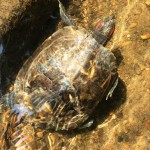- Species of Interest: Red-eared slider turtle (Trachemys scripta elegans)
- Origin: Southeastern United States
- Present all over the world
- Invasive Species
- Tolerant physiology
- The nervous system tissue of the red-eared slider turtle can survive in parts of the environment, in which there are low oxygen concentrations (anoxic conditions) and extreme temperatures. They can also survive severe mechanical injury to their spinal cord
- For example, the retinal of the red-eared slider turtle can withstand anoxic conditions
- The nervous system tissue of the red-eared slider turtle can survive in parts of the environment, in which there are low oxygen concentrations (anoxic conditions) and extreme temperatures. They can also survive severe mechanical injury to their spinal cord
- Learning Behavior
- In Dr. Dearworth’s Lab, the learning behavior of the red-eared slider turtle has been studied, through the use of operant conditioning. This study was performed with the help of research students Mitchel Mandel and Becca LaRosa
- In Dr. Dearworth’s Lab, the learning behavior of the red-eared slider turtle has been studied, through the use of operant conditioning. This study was performed with the help of research students Mitchel Mandel and Becca LaRosa
- Mammals vs. Turtles
- Mammals can only tolerate up to 2 hours maximum without breathing
- Birds can tolerate less than 2 hours
- Humans lose consciousness within seconds during severe hypoxic conditions (Ramirez et al., 2007)
- Turtles can last up to 4 months without oxygen, during winter dormancy
- To do this, the red eared slider turtle decreases its metabolic rate by 10-20%
- By decreasing its metabolic rate, the turtle is conserving its energy consumption (Herbert & Jackson et al., 1985)
- The hibernating metabolic rate of a turtle is 10,000 times lower than that of a mammal of similar size (Jackson, 2002)
- Mammalian neurons typically cannot tolerate hypoxic conditions
- In some cases, the neurons can only last minutes in the low oxygen conditions, (Staples et al., 2009)
- Retinal hypoxia causes blindness and ocular problems in mammals (Kaur et al., 2008)
- Aggressive behavior of the red-eared slider turtle
- It is thought that the species’ impressive adaptability to its environment and aggressive disposition are what allow the turtles to inhabit and thrive in non-native environments
- The increased concentration of Greenhouse gases in the atmosphere is also thought to contribute to the invasiveness of the species
- As a result of the increased concentration of Greenhouse gases in the atmosphere, there are warmer temperatures in northern environments. It is thought that these warmer northern environments permit the survival of the red-eared slider turtles. However, it is not known exactly how the species can survive in the northern areas of the world
Goal/Purpose/Hypothesis
- Purpose: To better understand the adaptive success of the red-eared slider turtle, (Trachemys scripta elegans), by examining turtle populations and environments and measuring the parameters or characteristics of each environment
- Hypothesis: Due to the impressive adaptability of the red-eared slider turtles, it was expected that more red-eared slider turtles would be found in anoxic environments

